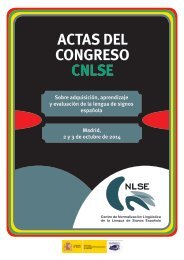ACTAS DEL CONGRESO CNLSE
1NMV0EE
1NMV0EE
Create successful ePaper yourself
Turn your PDF publications into a flip-book with our unique Google optimized e-Paper software.
PONENCIAS Y COMUNICACIONES <strong>DEL</strong> <strong>CONGRESO</strong> <strong>CNLSE</strong> SOBRE ADQUISICIÓN,<br />
54 APRENDIZAJE Y EVALUACIÓN DE LA LENGUA DE SIGNOS ESPAÑOLA 2014<br />
como recurso comunicativo sino como algo divertido, o porque les resulta más cómodo en determinadas<br />
situaciones y, además, porque ya forma parte de un juego en el que todos se sienten cómplices.<br />
Finalmente quisiéramos insistir en que el proyecto «Entiéndelo antes de hablar» se concibe como un<br />
soporte, un recurso, una herramienta más para facilitar la convivencia entre bebés y adultos. Incorporar<br />
la lengua de signos española tiene que ser un proceso divertido, interesante y anhelado por<br />
todos. El Manual se escribe intentando responder a cuantas preguntas puedan aparecer a lo largo del<br />
proceso, tanto el libro como el DVD se han diseñado para facilitar la tarea. Es una contribución más a<br />
la normalización de una lengua que poco a poco va alcanzando mayor relevancia en nuestras vidas.<br />
5. Referencias bibliográficas<br />
ACREDOLO, L. y GOODWYN, S. (2000): Los gestos del bebé: cómo hablar con tu hijo antes de que él sepa<br />
hablar, Barcelona: Oniro.<br />
ACREDOLO, L. y GOODWYN, S. (2002): My first baby signs, New York: Harper Collins Publisher.<br />
ANDERSOL, D. y REILLY, J. (2002): «The MacArthur communicative development inventory: normative data<br />
for American Sign Language», Journal of Deaf Studies and Deaf Education, 7(2): 83-106.<br />
BAYER. M. (2007): Hablar con tu bebé: una guía para aprender a utilizar la lengua de signos básica para<br />
comunicarte con tu bebé, Madrid: H. Blume.<br />
DEAFLIFE (2007): «The boom in baby signs: great for hearing babies-BUT what about deaf?», Deaflife: 33-45.<br />
DOHERTY-SNEDDON, G. (2008): «The great baby sign debate», The Psychologist 21(4): 300-303.<br />
ESPAÑA. Ley 27/2007, de 23 de octubre, por la que se reconocen las lenguas de signos españolas y se regulan<br />
los medios de apoyo a la comunicación oral de las personas sordas, con discapacidad auditiva y<br />
sordociegas. Boletín Oficial del Estado, núm. 255, pp. 43251–43259. (en línea) ‹http://www.boe.es/<br />
boe/dias/2007/10/24/pdfs/A43251-43259.pdf›.<br />
FUNDACIÓN CNSE (2011): Entiéndelo antes de hablar: ¿tiene hambre? ¿le duele algo? Ahora tu bebé te lo<br />
puede decir, Madrid: Fundación CNSE.<br />
GARCIA, J. (2003): Sign with your baby: how to communicate with infants before they can speak, Seattle:<br />
Sign2Me.<br />
GARCIA, J. (2008): «Established signs or non-standard signs?». (en línea) ‹http://www.sign2me.com/›.<br />
HELLER, L. (2004): Teaching your baby to sign, New York: Sterling Publishing.<br />
HERRERO, Á. (2009): Gramática didáctica de la lengua de signos española (LSE), Madrid: Ediciones SM,<br />
Fundación CNSE.<br />
PIZER, G. (2003): «Baby signing as a language socialization: the use of visual-gestural signs with hearing<br />
infants», Texas Linguistic Forum, 47: 165-171.




